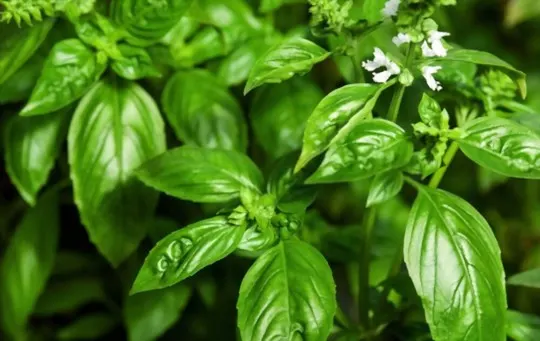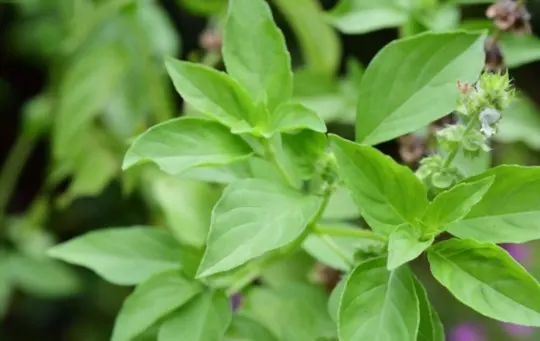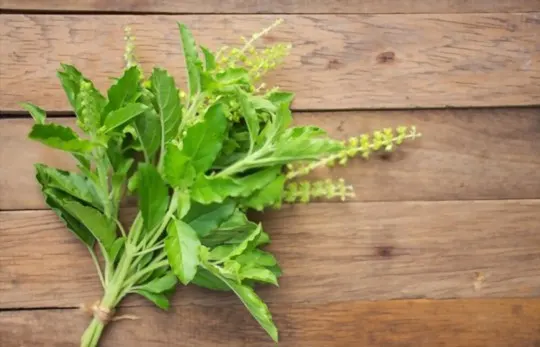Have you ever wanted to prepare a Thai dish, but not had the necessary ingredients?
Trying to find the best substitutes for Thai Basil whilst cooking can be a difficult task.
But don’t despair. You can still create fabulous dishes without it – find out how.
What’s Thai Basil?

Thai basil (Ocimum basilicum) is a type of basil that is native to Southeast Asia and it’s widely used in Thai, Vietnamese, and Laotian dishes.
It has a sharp, herbal flavor with a hint of clove-like sweetness, making it an ideal ingredient for seasoning curries, soups, salads, and more.
When choosing Thai basil at the store or market look for bright-green leaves with tips that are tightly curled.
The stems should be tender and avoid the yellowing varieties as these indicate the herb is past its prime.
Once you have your Thai basil it is essential to use it correctly ensuring you get all its flavors out into your dish.
The easiest way to use Thai Basil is fresh: if you’re making a soup or curry simply add them at the last moment so they can retain their full flavor – this should only take a few minutes.
You can also lightly stir-fry them in oil or butter along with other ingredients to add flavor to your dish or blend up and use as a seasoning paste.
If you want the true flavors of Thai Basil you will need to cook with fresh leaves – dried alternatives just don’t compare.
4 Best Thai Basil Substitutes in Cooking
However, due to its availability or because of an allergy, it’s not always easy to find.
But don’t worry.
This guide will provide you with four of the best Thai basil substitutes for your cooking.
1 – Sweet Basil

A sweet basil variety, also known as Italian basil, is an excellent substitute for Thai basil.
This type of basil is darker green in color and grows in a rounder shape than Thai basil.
Sweet basil has a milder flavor that is quite similar to the flavor of Thai basil, but with a hint of licorice similar to anise.
Sweet basil can be used in almost any dish that calls for Thai Basil — from soups and salads to stir-fries and curries.
The main difference between sweet and Thai basils lies in the presence of the anise flavor; if the anise flavor is not desired, then sweet basil is an ideal substitution for Thai Basil.
2 – Lemon Basil

Lemon basil is a fragrant variety of basil with bright, citrusy flavor.
It has variegated leaves that have creamy white and green hues.
The flavor of lemon basil can range from mild to quite intense, depending on how you harvest and store it.
If you’re using it fresh, chop the leaves more finely to make the flavor subtler; if using dried, use less than usual because the intensity will be greater.
In terms of taste, lemon basil is similar to regular sweet basil but with a zesty edge that adds depth and brightness to any dish.
It pairs particularly well with fish and pork dishes as well as Mediterranean-style salads and dressings.
This variety of basil works especially well in cold dishes such as gazpacho or vinaigrettes; it also makes a great substitution for Thai basil in many recipes due to its slightly sweeter taste and vibrant aroma.
Lemon basil can also be used in tea infusions or sauces for baking recipes such as banana bread or pumpkin bread for an added touch of zing.
3 – Holy Basil

Holy basil, or Tulsi, is member of the mint family.
It is slightly more pungent than Thai basil and has a stronger pepper flavor with slight notes of cinnamon and anise.
It grows best in warmer climates where temperatures are consistently over 75°F (24°C), which makes it less common in many northern areas.
Most grocery stores will not stock this variety due to its inability to stay fresh for long periods of time.
Regardless, holy basil can still be found at some specialty grocery stores or online retailers.
When making dishes with holy basil, make sure to add it near the end of cooking time so that its flavor retains its fullness and aroma.
It’s often served with rice dishes as a condiment, particularly popular in Thailand and India.
4 – Cinnamon Basil

Cinnamon basil is a sweet, spicy herb that really packs a flavorful punch.
It has a more subtle flavor than Thai basil, but it can still give your dish incredible depth.
While Thai basil has an anise-clove flavor and a lemony taste, cinnamon basil’s flavor is more of an earthy cinnamon and clove.
This type of basil performs well in most dishes, substitutes for both sweet and savory ones, and is especially useful for making flavored oils.
If you’re looking for some creative uses for cinnamon basil, try adding it to pesto sauces or herb butter for a unique twist on classic recipes.
For hot dishes, use it to top off curries with a wonderful pop of flavor.
Conclusion
Ingredients vary from culture to culture and finding the right ingredients can be a challenge when it comes to creating classic ethnic dishes.
Thai basil is an essential ingredient in many Thai dishes, but if it’s unavailable, there are plenty of other ingredients you can use to get a similar flavor.
While there’s no perfect substitute for Thai basil, by using any of these four herbs, you can still create delicious and flavorful dishes in your kitchen.

4 Best Thai Basil Substitutes in Cooking
Ingredients
- 1 – Sweet Basil
- 2 – Lemon Basil
- 3 – Holy Basil
- 4 – Cinnamon Basil
Instructions
- Choose your preferred substitute from the list of options.
- Organize all of your ingredients.
- Use the proper substitute to cook your recipes.

Carrie is a food writer and editor with more than 15 years of experience. She has worked for some of the biggest names in the food industry, including Bon Appétit, Food & Wine, and Martha Stewart Living.
As the Editor in Chief of IntroChicago.com, Carrie oversees all of the content on the site. She also manages the team of contributing writers and editors, who help to create delicious recipes, helpful tips, and informative articles that you’ll find on the site.
A native of the Chicago area, Carrie is passionate about all things food. She loves trying new restaurants and experimenting with new recipes in her kitchen. She’s also a graduate of the Culinary Institute of America, so she knows a thing or two about food!
